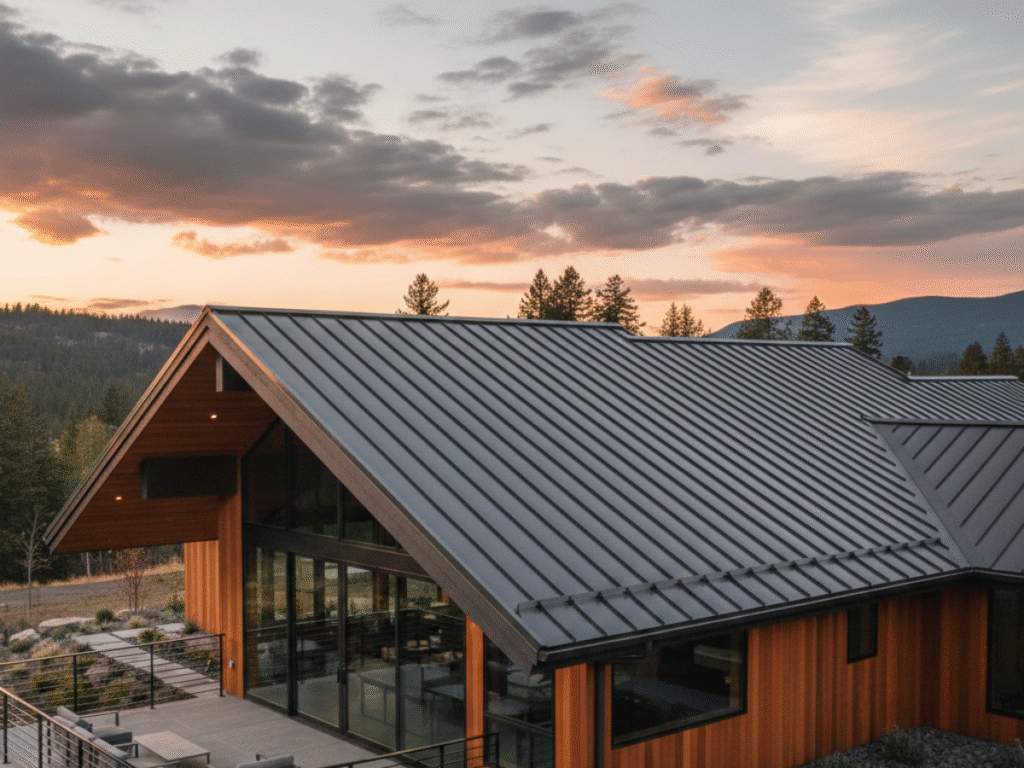Key Takeaways
Metal roofing shingles cost more upfront, but they offer longer life, stronger durability, and lower long-term expenses. Shingles remain a simple and affordable option but usually require more replacements. The Metal Shop focuses on producing high-precision metal products, so this guide breaks down the true value from a manufacturing point of view.
Introduction
The main reason metal roofing feels more expensive than shingles is the stronger materials and longer life cycle. Metal roofing shingles use high-grade metals that deliver durability across decades.
Choosing between metal roofing shingles and traditional shingles often starts with a cost question. Homeowners want to know which option fits their budget today and which pays off later. The Metal Shop manufactures durable metal components, so we see first-hand how material grade, finish quality, and panel precision influence performance. This guide stays focused on how each roofing material compares from a production and long-term value perspective, without touching field work. By the end, you will clearly understand whether metal roofing or shingles give you better value.
What Makes Metal Roofing Shingles Different?
Metal roofing shingles use engineered metal panels designed to handle decades of weather without losing form or strength. They are built from steel, aluminum, or premium alloys that stay stable even when temperatures swing hard. If you’re installing or modifying panels, choosing the best tool to cut metal roofing helps ensure clean edges and precise fitting. Because The Metal Shop fabricates metal systems with tight tolerances, the consistency and repeatability matter as much as the material itself.
Metal roofing shines when it comes to durability. The metal surface resists cracks, rot, and moisture retention. Even in harsh climates, these materials hold their shape while staying lighter than many roofing surfaces. From a manufacturer’s view, metal roofing shingles deliver predictable quality, and that uniformity is a major reason they last so long.
Understanding Shingles From a Material Perspective
Shingles rely on layers of asphalt, fiberglass, and granules. They are familiar, widely used, and cost-effective on day one. However, shingles break down faster under UV exposure, wind movement, and heavy rain. Their granules wear off, the asphalt dries, and the material becomes vulnerable to cracking.
While shingles are practical, they simply do not offer the structural life that metal roofing shingles do. Their strength depends heavily on climate and the quality of the base materials. Over time, most shingle roofs need multiple replacements, which increases overall lifetime cost.
The Real Reason Metal Roofing Costs More at First
Many people search, is metal roofing better than shingles? The answer depends on what you value more, initial savings or long-term performance.
Metal roofing requires higher-grade materials, specialized coatings, and controlled fabrication processes. These materials are built for decades of use, so they naturally cost more to produce. Manufacturers like The Metal Shop focus on precision cuts, clean edges, and protective finishes that prolong the roof’s life. This level of production quality explains why metal roofing shingles have a higher starting price.
Shingles, by comparison, are cheaper to produce because the material layers are less expensive and the manufacturing process is more widespread. The upfront savings are real, but that cost advantage doesn’t always hold up over twenty or thirty years.
Long-Term Value: Where Metal Roofing Takes the Lead
Metal roofing shingles offer a lifespan that often stretches several decades. They resist heat, storms, impact, and moisture in ways that standard shingles cannot. This long-term durability creates predictable savings because homeowners avoid multiple rounds of shingle replacements.
Shingles typically last fifteen to thirty years depending on weather and material grade. Their decline happens slowly, but once granule loss and cracking begin, larger repairs follow. Over a long enough timeline, replacing shingles two or three times usually exceeds the total cost of keeping one metal roof in place.
From a manufacturing perspective, this is the exact value metal aims to provide, strength that stays reliable for a lifetime.
Maintenance Differences Between Metal Roofing and Shingles
Metal roofing needs minimal maintenance because it resists the most common roofing issues, moisture damage, cracking, rotting, and heat fatigue. Most upkeep focuses on clearing debris and checking surface conditions. The Metal Shop fabricates metal components with coatings that help them stay stable for many years.
Shingles require more frequent attention. Their layered material structure is sensitive to wind uplift, temperature shifts, and surface wear. Over time, this creates more patching, more shingle replacement, and more routine upkeep.
If you value fewer maintenance needs and predictable longevity, metal roofing shingles win with ease.
Energy Efficiency: How Metal Helps Manage Heat
Metal roofing reflects more sunlight than shingles, which helps reduce heat transfer into the home. This ability to stay cooler can lower energy use during summer months. Shingles absorb more heat and tend to warm the home more during peak temperatures.
Because metals resist thermal changes better, they help stabilize indoor comfort. While this does not replace insulation, it adds another layer of practical value. For homeowners in hot climates, metal roofing often becomes the more efficient long-term choice.
Total Cost of Ownership: Which Is Truly Cheaper?
When you look past the upfront price, metal roofing shingles usually come out ahead. They last longer, require fewer repairs, and help manage heat more efficiently. That extended lifespan is where most of the savings happen.
Shingles remain the quick and affordable move, but they bring higher lifetime upkeep. Two or more full replacements often cost far more than the single long-lasting metal roof you would have instead.
The Metal Shop sees this pattern often when producing systems for contractors and suppliers. Metal simply performs better in the long run.
Conclusion
Metal roofing shingles demand more investment at the beginning, but they deliver unmatched value across decades. Shingles are friendly to the wallet upfront but require more maintenance, more replacements, and more frequent attention. If you want long-term stability and predictable performance, metal roofing becomes the smarter choice. The Metal Shop manufactures metal products built for durability, and that strength is what makes metal roofs a powerful long-term solution.
FAQs
1. How long do metal roofing shingles typically last?
Metal roofing shingles often last several decades because of their strong material structure.
2. Are metal roofing shingles more durable than regular shingles?
Yes, metal is naturally stronger, more weather resistant, and less prone to cracking or aging. We supply the materials only. Installation is handled by your contractor.
3. Is metal roofing better than shingles for long-term value?
Metal roofing usually delivers better long-term value due to fewer replacements and lower upkeep.
4. Do metal roofing shingles help with energy efficiency?
Metal reflects more heat than shingles, which can help manage indoor temperatures. The Metal Shop provides the fabricated metal panels, while installation is handled by your contractor.

